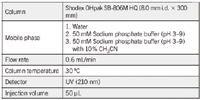Effects of Solvent pH on the SEC Analysis of Sodium Polyacrylate
Shodex/Showa Denko America Inc.
Sodium polyacrylate has a wide commercial and industrial application. Molecular weight (MW) distribution analysis is an important part of product quality control. Shodex OHpak SB series columns are polymer based SEC columns suitable for the analysis.
Surrounding solvent pH influences the dissociation level of the carboxylic group in sodium polyacrylate's main chain, and thus the polymer may exhibit as negatively charged or neutral compound. Charged polymer can cause undesired interaction with column packed gel as well as ionic interaction within the polymer. These interactions may result in alternation of the SEC analysis. Therefore, in this study, we optimized the solvent pH. Sodium polyacrylate of three different molecular weights were analyzed. We compared recovery rate and calibration linearity at each condition to examine the effects of undesired interactions.
Experimental Conditions

Sample: 0.1% Sodium polyacrylate (Standard obtained from Polymer Standards Service-USA).

Results and Discussion
Under 100% water mobile phase condition, all sodium polyacrylate was eluted as front (Figure 1). This indicates the presence of ion-exclusion effect occurred between carboxylic group in sodium polyacrylate and packed gel. At lower pH, polymer dominates in none dissociated form (-COOH). This prevents ionic type interactions; however increased hydrophobicity causes the polymer to be adsorbed on to the hydrophobic part of the packed gel. Delayed elution and low recovery were observed at pH 3. This trend was more obvious for the larger polymers. Most likely, since the bigger MW polymers exhibit stronger hydrophobicity, they are more prone to hydrophobic adsorption. The fact that addition of 10% acetonitrile reduced the elution time while increased the recovery rate also confirmed the presence of hydrophobic interaction (data not shown). At pH > 7, dissociated (-COO- ) forms of polymer dominates, and thus minimizes the hydrophobic interaction. Also, the presence of buffer salt suppresses the ionic interactions. The resulting recovery rates were close to 100%. The addition of acetonitrile did not affect the elution time for both pH = 7 and 9 conditions; this indicates the minimum presence of hydrophobic interaction.

Figure 1: Sample chromatograms of three sodium polyacrylate analyzed at different conditions. Mobile phase: Water, 50 mM sodium phosphate buffer adjusted at pH = 7, and at pH = 3.
Conclusions
We have optimized conditions for the analysis of sodium polyacrylate using an aqueous polymer SEC column, Shodex OHpak SB-806M HQ. Sodium polyacrylate polymer of different MW showed different level of hydrophobic and ionic interaction at lower pH conditions. Mobile phase having pH > 7 was found to be an effective condition for the accurate MW distribution analysis of sodium polyacrylate tested in this study without observing any undesired interactions.
Shodex/Showa Denko America Inc.
420 Lexington Avenue Suite 2335A, New York, NY, 10170
tel. (212) 370-0033 x109, fax (212) 370-4566
Website: www.shodex.net

SEC-MALS of Antibody Therapeutics—A Robust Method for In-Depth Sample Characterization
June 1st 2022Monoclonal antibodies (mAbs) are effective therapeutics for cancers, auto-immune diseases, viral infections, and other diseases. Recent developments in antibody therapeutics aim to add more specific binding regions (bi- and multi-specificity) to increase their effectiveness and/or to downsize the molecule to the specific binding regions (for example, scFv or Fab fragment) to achieve better penetration of the tissue. As the molecule gets more complex, the possible high and low molecular weight (H/LMW) impurities become more complex, too. In order to accurately analyze the various species, more advanced detection than ultraviolet (UV) is required to characterize a mAb sample.

.png&w=3840&q=75)

.png&w=3840&q=75)



.png&w=3840&q=75)



.png&w=3840&q=75)














